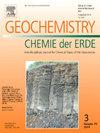Unique achondritic impact debris in the CH3 chondrite Acfer 182
IF 2.9
3区 地球科学
Q2 GEOCHEMISTRY & GEOPHYSICS
引用次数: 0
Abstract
The metal-rich CH carbonaceous chondrites contain abundant xenolithic clasts originating from different regions of the Solar System. In the CH3 chondrite Acfer 182, we identified two phosphide spherules (one 95-μm in diameter and the other ) of schreibersite ((Fe,Ni)3P) and barringerite ((Fe,Ni)2P) with kamacite eutectic structures. These objects are likely to have formed during an impact between planetesimals during the debris-disk phase of the protoplanetary disk before being incorporated into the CH chondrite parent body. In the same sample we identified a heideite grain (iron‑titanium sulfide: (Fe,Cr)1.15(Ti,Fe)2S4) with exsolution lamellae of calcium-rich titanium oxide. Thin veins of shock-induced kamacite cross-cut the oxide lamellae, suggesting that it was ejected into the protoplanetary debris disk during an impact event before eventually being accreted by the CH chondrite parent body. This assemblage is distinct from heideite grains found in enstatite chondrites, aubrites, and the Kaidun meteorite. We propose that this object originated from a highly-reduced planetesimal in the inner Solar System that may have been similar to proto-Mercury.
CH3球粒陨石Acfer 182中独特的球粒陨石撞击碎片
富含金属的CH碳质球粒陨石含有丰富的源自太阳系不同区域的xenolithic碎屑。在CH3球粒陨石Acfer 182中,我们发现了两个具有卡玛石共晶结构的磷化小球体(一个直径为95 μm,另一个直径为50μm×60μm),分别为schreiberite ((Fe,Ni)3P)和barbarerite ((Fe,Ni)2P)。这些物体很可能是在原行星盘的碎片盘阶段的星子之间的撞击中形成的,然后才被合并到CH球粒陨石母体中。在同一样品中,我们发现了一个130μm×60μm海氏体晶粒(铁-硫化钛:(Fe,Cr)1.15(Ti,Fe)2S4),具有富钙氧化钛的析出片层。激波诱发的细脉状卡玛石横切了氧化物薄片,表明它在撞击事件中被抛射到原行星碎片盘中,最终被CH球粒陨石母体吸积。这种组合不同于在顽辉石球粒陨石、灰长岩和开盾陨石中发现的铁粒。我们提出,这个物体起源于太阳系内部的一个高度还原的星子,可能类似于原水星。
本文章由计算机程序翻译,如有差异,请以英文原文为准。
求助全文
约1分钟内获得全文
求助全文
来源期刊

Chemie Der Erde-Geochemistry
地学-地球化学与地球物理
CiteScore
7.10
自引率
0.00%
发文量
40
审稿时长
3.0 months
期刊介绍:
GEOCHEMISTRY was founded as Chemie der Erde 1914 in Jena, and, hence, is one of the oldest journals for geochemistry-related topics.
GEOCHEMISTRY (formerly Chemie der Erde / Geochemistry) publishes original research papers, short communications, reviews of selected topics, and high-class invited review articles addressed at broad geosciences audience. Publications dealing with interdisciplinary questions are particularly welcome. Young scientists are especially encouraged to submit their work. Contributions will be published exclusively in English. The journal, through very personalized consultation and its worldwide distribution, offers entry into the world of international scientific communication, and promotes interdisciplinary discussion on chemical problems in a broad spectrum of geosciences.
The following topics are covered by the expertise of the members of the editorial board (see below):
-cosmochemistry, meteoritics-
igneous, metamorphic, and sedimentary petrology-
volcanology-
low & high temperature geochemistry-
experimental - theoretical - field related studies-
mineralogy - crystallography-
environmental geosciences-
archaeometry
 求助内容:
求助内容: 应助结果提醒方式:
应助结果提醒方式:


